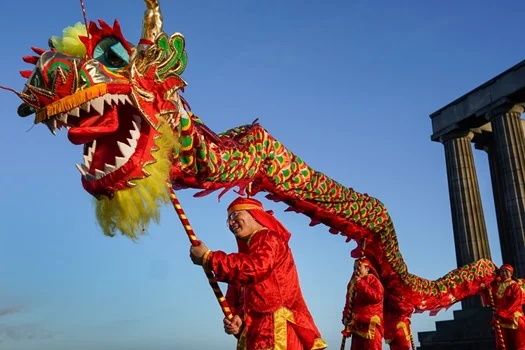Chinese New Year 2024: Date, History, Significance, Celebration

The Lunar New Year observance is also called as the Chinese New Year, a 15-day commemoration that starts on the first day of the new moon in January to February, depending on Western calendars. This celebration continues until the next full moon.
Since the dates of celebration match the phases of the moon, the festival is known as the Lunar New Year. Spring Festival, a phrase used to describe the Chinese New Year in particular, has been declared this week as Spring Festival.
Chinese New Year 2024 will be celebrated on February 10, 2024.
Chinese New Year History
The Chinese New Year is at least 4,500 years old. The festival’s origins are said to date back to the Shang Dynasty (1600-1046 BC) when individuals revered ancestors and gods at the beginning of the year, when there were only 12 months in the year.
Beginning agriculture on New Year’s Day was a cultural tradition in the Western Zhou Dynasty (1046-256 BC). Offerings were made to ancestors or gods in order to placate or thank them, and reverence for nature was used to bless crops.
The Festival of the First Month in the Chinese Lunar Calendar was established as the celebration’s date in the Han Dynasty (202 BC – 220 AD). Ceremonial gathering and utilizing pyrotechnics in the form of burning bamboo to create a loud noise were some of the rituals that were adapted by the people.
During the reigns of the Wei and Jin dynasties (220-420 AD), people did their own things besides praying to the gods and ancestors. During this time, family traditionally gather together to clean and decorate their home, and then have a reunion meal.
At the end of the Tang Dynasty, in the Year of the Sheep, the Chinese New Year celebration moved away from prayer and worship to focus on recreation. Locally, riddles were hung on light posts. There are public holidays set out for family reunions and celebrations.
To correct the problems created by the old lunar calendar, the government replaced it with the Gregorian calendar in 1912. As a result, many people were not ready to alter the longstanding practice, and they continued to use both calendars. In 1949, the People’s Republic of China was established and after that the New Year was designated as a national public holiday. This meant that people had additional days off at their jobs and in school.
Chinese New Year Significance
Over the years, Chinese New Year has grown very famous in China and across the world, helping to promote Chinese culture throughout the world.
In many areas of the world, it is also celebrated, for example, in Australia, Malaysia, Singapore, Bangkok, Thailand, Mauritius, and certain places in North America. One of China’s most significant holidays is celebrated throughout the 15 days before and continuing until New Year’s Eve, and it starts with the reunion supper.
A fresh beginning is often marked by the commencement of a celebratory ceremony. It signifies the beginning of spring in the Chinese lunar calendar, and also marks the New Year for the Chinese calendar.
It is a traditional holiday when family come together to rejoice, spend time together, and strengthen their bonds. It is believed that hosting the event brings great luck for the following year. Early on, the party was intended to provide farmers and labourers some relaxation after hard labour, and then let them to return to their jobs after a vacation. During the Chinese New Year, people utilise animals from the Chinese Zodiac to symbolise each year. In 2021, the year was celebrated as the Ox year.
According to a Nian folklore, people in China light firecrackers to chase away evil creatures and ill luck on Chinese New Year’s Eve. During the early hours, lighting firecrackers is seen as a sign of good luck to greet the New Year.
About Celebration of Life Day
Chinese New Year Celebrations
During the 15-day Chinese New Year celebration, people observe a variety of rituals and traditions:
On Chinese Fresh Year, people prefer everything new for the celebration and clean the walls, ground, and corners of their home to drive away the old items and bad energy and prepare for a new start.
The elders purchase new clothing for the whole household. On New Year’s Day, everyone in the family puts on new clothing.
It’s the ideal time to go home, meet up with friends and family, and arrange a reunion dinner.
After the reunion meal, the older members of the family present red envelopes, also known as lucky money, to the youngsters.
A Chinese New Year tradition is to eat flour dumplings filled with various fillings, which are said to bring prosperity in the next year.
People plaster “Fu” upside down on their gates during the Chinese New Year to signify the advent of happiness or good fortune.
The colour red is linked with prosperity and good fortune in Chinese culture. The bright red decorations are placed to keep off a creature that looks like a lion.
The sticky rice balls, also known as Yuanxiao or Tangyuan in Chinese, are a traditional delicacy during the Chinese New Year and are glued on doors as part of the festival’s décor.
Chinese lanterns, which are constructed of sticky rice flour and filled with various contents, are lighted around the streets, and poetry and riddles are inscribed on them for amusement.
FAQs
February 10, 2024
Chinese new year is celebrated as a 15-day festival and it is also popular as spring festival.
Rat, tiger, ox, rabbit, snake, dragon, horse, monkey, sheep, rooster, dog, or pig




